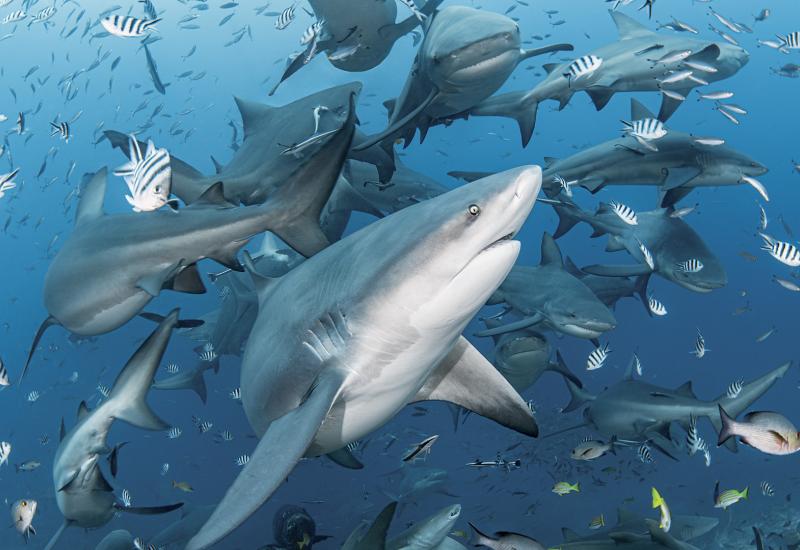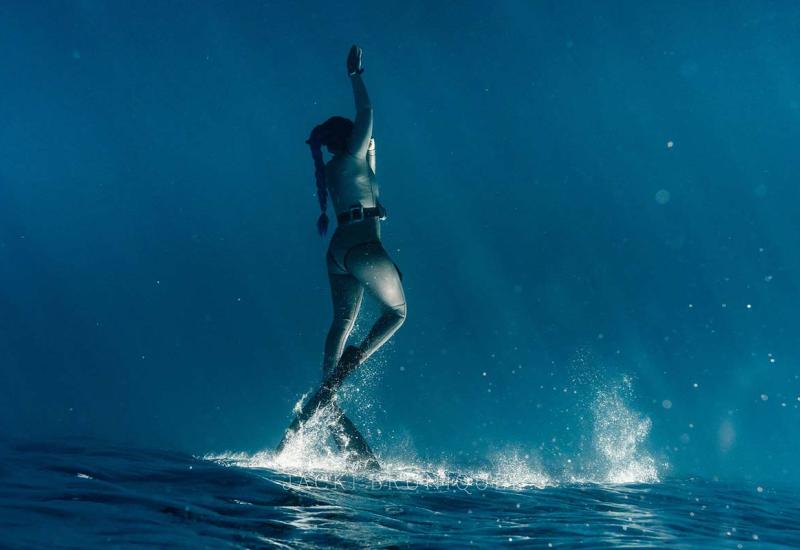Sardine Run Fever on South Africa's Wild Coast
Any diver seeking life-changing adventure has heard of South Africa’s Sardine Run. There are other runs—Mexico, Philippines, even the fjords of Norway—but this is the run, the one run to rule them all.
It just may be the largest migration of marine life on the planet, a many-miles-long, pile-on-top-of-each-other movable feast attended by dolphins, whales, sharks, birds and, of course, billions of fish. At the middle of this melee is the oily main course, the humble sardine. Along a rugged and remote stretch of South Africa’s eastern seaboard, aptly named the Wild Coast, our little hero is harried ceaselessly by a plethora of predators. Also in attendance is a rare breed of hardy and truly dedicated diver, willing to roll the dice with Mother Ocean and give 110 percent for a chance to witness this trial of life unfold, raw and unscripted, in surging seas boiling with life.
PORT ST. JOHNS, GATEWAY TO THE SARDINE RUN

Brandon ColePort St. Johns is headquarters for many Sardine Run operators.
The run is a living phenomenon—dynamic, unpredictable and always on the move. Operators are based up and down South Africa’s Eastern Cape and southern KwaZulu-Natal provinces, from Port Elizabeth in the south to Mbotyi in the north. Port St. Johns (PSJ) is headquarters for many companies. Above, a group leaves PSJ early one morning, motoring down the Umzimvubu River before charging through sometimes punishing surf out into big water. Most operators use rigid inflatable boats—ideal for quick, easy access into the water, but not always dry or comfortable.
Sardine Run 101

Brandon ColeBryde's whale.
At its core, the run is a story about Sardinops sagax. As winter approaches and the nutrient-rich, temperate seas off the bottom of Africa cool down, huge shoals of sardines migrate northward toward their spawning grounds off KwaZulu-Natal. The sardines follow a thin finger of the cold Benguela countercurrent close to land, inside the warmer Agulhas current, which flows in the opposite direction, north to south, farther offshore. Since they prefer water temperatures of 57 to 68 degrees Fahrenheit, mind-boggling numbers of sardines are effectively funneled up the coast, hugging the narrow continental shelf and feeding on plankton as they travel. This silver river attracts an assemblage of ocean predators of epic proportions. Fish and fowl join dolphin and leviathan to feast on the bounty. Bryde’s whales (above) often uncannily arrive unseen, rocketing into the orbiting mass with surprising speed, cavernous mouth agape. Balaenoptera edeni are 20-ton, 35-foot-long ambushers that can swallow a baitball in one gulp.
ZEST FOR LIFE

Brandon ColeLong-beaked common dolphins.
Long-beaked common dolphins (Delphinus capensis) travel in pods usually numbering between 100 and 500. Sometimes pods merge to form a “superpod” a few thousand strong. Racing in a boat alongside fast-traveling dolphins is one of the run’s top thrills— their zest for life is contagious. Indo-Pacific bottlenose dolphins (Tursiops aduncus) are also encountered, but rather than feeding you’ll likely see them leaping and surfing the perfect wave just before it thunders ashore.
LOOK SHARP

Brandon ColeBlacktip and copper sharks.
Blacktip (Carcharhinus limbatus) and copper sharks (C. brachyurus) join common dolphins in the feeding frenzy. Duskies (C. obscurus) are also regular visitors; lucky divers and snorkelers have witnessed more than 100 sharks on a single baitball. With so many predators about, humans must exercise caution. When visibility is poor, it may be wise to stay out of the water and enjoy the action topside.
EYE IN THE SKY

Brandon ColeGyrocopter.
Aircraft such as this gyrocopter provide invaluable spotting support. Skilled pilots can survey extensive ocean real estate, quickly locating the action and directing tour boats to dolphin herds, humpbacks, random rarities like orcas, billfish and mantas, and of course, the fish. The main shoal can be 4 miles long and a mile wide, with baitballs up to 50 feet in diameter.
SIDESHOW ENTERTAINMENT

Brandon ColeHumpback whale.
When a humpback whale throws its weight around, cameras fire and divers smile. Megaptera novaeangliae is a Sardine Run celebrity, yet, technically speaking, it’s not—better to classify it as a 30-ton bonus. Humpbacks are here not for the fish but because these waters include their migratory path. Each year they travel from summertime feeding grounds in Antarctic waters to their wintertime hangout off Mozambique, where they mate and give birth. Humpbacks ignore the sardines and instead pursue the art of breaching, lobtailing and goofing around, to break up the monotony of their long pilgrimage. Sometimes whales are curious about us. One of my top moments on my last run was a one-hour swim with an extraordinary whale hellbent on making contact. Huffing and puffing and whooping with delight through my snorkel, it was all I could do to focus on keeping at least a few inches between me and its barnacle-studded snout and friendly, windmilling flippers reaching out for a big hug.
BY AIR AND SEA

Brandon ColeSeabirds.
Many species of seabirds cash in on the baitfish bonanza. Tens of thousands of Cape gannets follow the run northward. When you see Morus capensis plunging like missiles in rapid succession, be ready to jump in—it’s usually an excellent sign that the game is on. Superb swimmers, gannets can dive 30 feet deep. With amazing speed and dexterity, they chase and catch sardines, swallowing them while still underwater.
REALITY CHECK
If only it were all nonstop baitballs and glorious Blue Planet action. But nature rarely plays that way. Every day has the potential to be the most exciting day of your life aquatic—or, nothing will happen. Or seas will be too rough. Or the fish move so fast even Michael Phelps would be left in the dust. Or your boat arrives late, just seconds after the symphony of chaos peters out. You might nail insane whales double-breaching but strike out with birds feeding, while an ecstatic radio report of another boat’s guests hitting the mother lode drives you to tears. The run is a complex biological and environmental machine, with lots of moving parts that need to be working together in harmony to deliver the Holy Grail, that stationary baitball in clear water with all predators present and accommodating. Such events are rare, even if social media screams the opposite. Some people do luck out in only a few days, while others devote weeks to the run yearly, to create luck over time. Weather and wildlife are impossible to predict, and become even more so as the climate changes. If commercial fishing increases, it could threaten sardine stocks. Nothing is guaranteed, except that you have to be in it to win it. Don that cold, clammy wetsuit and give it your everything. Mother Ocean usually—eventually—favors the bold with the greatest shoal on earth.
SARDINE RUN NEED TO KNOW
WHEN TO GO: Historically, the run occurs off Port St. Johns during June and July. Some years it’s early, some years late, and on rare occasions—2003, 2006—it doesn’t materialize close enough to shore to be accessible. The run can also be experienced around Port Elizabeth between March and May.
DIVE CONDITIONS: Water temperature ranges from 59 to 71 degrees Fahrenheit. Use a full 5 or 7 mm wetsuit. Expect occasional rough seas, strong wind, swell and low viz (10 to 50 feet, sometimes worse, sometimes better). Snorkeling is best when sardines are moving fast; static events may provide opportunity for scuba. Outings can be strenuous; good fitness and experience in small open boats is important to safely enjoy this sometimes extreme activity.
TRAVEL TIPS: Do whatever you can to extend your trip beyond one week, to gain flexibility for the unpredictability of the weather and the run. Fly through Johannesburg (JNB) into Mthatha (UTT) to shorten the transfer to PSJ to 11⁄2 hours versus six hours from Durban.
OPERATOR: Offshore Africa Port St. Johns. Very experienced, and the only Sardine Run specialist based full time on the Wild Coast. They offer customizable packages, with an eight-person maximum per boat, and have exclusive use of a dedicated gyrocopter aircraft for aerial spotting support. Its owner/operators are members of the Sardine Run Professional Association.
HOW TO VET A SARDINE-RUN OPERATOR: To find a good match for your expectations and experience level, consider asking: How long have they been doing the Sardine Run? Do they have aerial spotting support? If yes, is it shared or exclusive? Do they offer scuba, or only snorkeling? How long do they spend at sea? How many people in the boat? Does everybody get in the water at once, or do they rotate teams? Are they a member of the Sardine Run Professional Association, to ensure they follow safe and ethical operating procedures? What happens on slow days—do they dive on a local reef, stay out looking for topside wildlife, or head home early? Do they offer terrestrial activities if bad weather cancels a day at sea?
PAST SARDINE RUN COVERAGE
• The Greatest Shoal on Earth
• Field Report from South Africa's 2017 Sardine Run
• The World's Most Epic Feeding Frenzy











